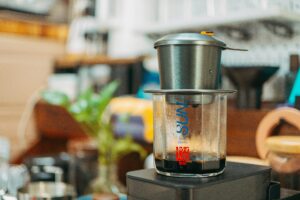Espresso, once a hallmark of European coffee culture, has seen a phenomenal surge in popularity, especially amongst aficionados looking to recreate that perfect crema in their own kitchen. For home baristas, selecting the right beans is a crucial first step in their espresso-making adventure. The question of whether regular coffee beans can be transformed into a satisfying espresso shot is a puzzler that many have pondered. In this post, we’ll explore the intricacies of coffee bean selection, taking an analytical and experiential approach to demystify the process and provide valuable insights for your next coffee experiment.
Table of contents
Understanding the Brews: Coffee vs. Espresso
Before we grind this bean to dust, it’s essential to recognize the fundamental differences between a classic cup of Joe and the concentrated elixir that is espresso.

The Core Definitions
Coffee: A broad term for the beverage brewed from ground coffee beans with hot water. It’s known for its comforting aroma, balanced flavor, and the intimate ritual it often accompanies.
Espresso: A specific preparation method that brews finely-ground, dark-roasted coffee beans by forcing hot water through them at high pressure. The result is a small, concentrated shot with layers of rich flavors and a creamy top — the prized crema.
The Brewing Process
The key to espresso is the intense interaction between finely-ground beans and pressurized water, often delivered at a higher temperature than coffee. This process, typically lasting 25-35 seconds, extracts a more potent flavor profile and distinctive body that’s thicker than traditional coffee.
Can Regular Beans Perform as Espresso Maestros?
Coffee and espresso beans are not as dissimilar as their marketing suggests. Any coffee fan knows that single-origin beans can be infinitely complex and nuanced. Yet, nuances in the roast and grind are what set them apart.
Roast Level Matters
Espresso beans are generally roasted to a dark level to provide the robust flavor and oils required for the crema. However, the ‘dark’ descriptor doesn’t mean one-dimensional — good espresso beans still retain some acidity for balance. Regular coffee beans, in contrast, typically undergo a lighter to medium roast, preserving more subtler flavors.
The Grind-Size Conundrum
Consistency in coffee ground size is critical. For espresso, the grounds should resemble fine sand, allowing for the high-pressure extraction to work its magic. If using regular coffee grounds, which are coarser, the water will pass through too quickly and the resulting shot will be under-extracted — weak and watery.
The Great Espresso Experiment
To answer definitively whether regular coffee beans can make good espresso, a hands-on approach is best. We conducted an at-home experiment, using a popular espresso machine and regular medium-roast coffee beans. Here’s how it went down.
Tools and Methodology
We employed a conical burr grinder to achieve a fine consistency in grinding, crucial for mimicking the espresso grounds. Using a 2oz portafilter, we pressed the grounds with appropriate force to create a tightly packed puck.
Observations and Tasting Notes
The resulting shot was surprisingly close to a classic espresso — rich, strong, with hints of the bean’s character shining through. The lack of a pronounced crema was noticeable, likely due to the lighter roast, but the taste and texture were compelling nevertheless.
Barista Insights and Tips for Success
We reached out to professional baristas and stalwart coffee aficionados for their perspectives on the regular bean-espresso debate. Their insights yielded crucial advice for those wanting to explore this path.
Grinding It Right
The consensus was clear — the grind size should be finer than what you’d use for a standard drip coffee maker. Experiment with different fineness levels, but err on the side of too fine; you can always adjust to a coarser setting if necessary.
The Perfect Extraction
For good espresso extraction, aim for a brewing time between 20-30 seconds. The ideal yield is around 1oz of liquid, but don’t fear experimenting here either. Taste is king, and adjustments to time and quantity can fine-tune your shot.
Selecting Suitable Beans
Seek high-quality, fresh regular coffee beans. Avoid any that are over a month past roasting date, as they may have gone stale. Look for beans described as having complex or robust flavor profiles, as these tend to perform better when concentrated.
Can You Use Regular Coffee In An Espresso Machine?
While the experimentation with regular coffee beans in an espresso machine has yielded promising results, it’s crucial to understand when and why you might choose regular beans over those designated for espresso. The simple answer is yes, you can use regular coffee in an espresso machine, but with a few caveats. The success of this venture largely depends on the bean’s roast, the grind size, and your personal taste preferences.

Espresso Vs Regular Coffee
The primary difference between using espresso beans and regular coffee beans lies in the bean’s roast level and the grind size. Regular coffee beans are often roasted lighter than espresso beans, resulting in a more nuanced flavor profile that can be lost under the intense pressure of espresso brewing.
When Should You Use Regular Coffee Instead of Espresso?
Using regular coffee beans is ideal for those seeking to experiment with flavors and intensities beyond the traditional espresso roast. It’s also a practical option if you’re in a pinch and don’t have espresso beans on hand. However, for a true espresso experience with the characteristic crema and depth of flavor, specially roasted espresso beans are recommended.
The Best Coffee For Espresso
The optimal beans for espresso tend to be those with a dark roast, fine grind size, and fresh roast date. However, this doesn’t mean you should limit yourself to these criteria strictly. Many baristas enjoy exploring the nuances of single-origin beans or lighter roasts, even in their espresso machines.
What Type of Beans Is Best for Espresso?
To achieve the classic espresso taste, beans with a darker roast and a robust, complex flavor profile are preferred. These characteristics ensure the coffee can withstand the pressure of espresso brewing, producing a rich, concentrated shot.
How Does Grind Size Change Your Espresso?
The grind size is critical in espresso making. Too coarse a grind and the water will pass through too quickly, resulting in a weak shot; too fine, and you might face clogging issues or an overly bitter taste. Finding the right grind size is a delicate balancing act that can dramatically impact the quality of your espresso.
What Roast Level Should You Look For?
For traditional espresso, a dark roast is usually sought after because it offers the bold, robust flavor and the necessary oils to create a rich crema. However, don’t shy away from medium roasts, as they can provide a more nuanced flavor profile, although they might produce less crema.
The Tasting Conclusion
While it’s clear that using regular coffee beans for espresso is possible, it might require a bit more persistence and tweaking. The shot may not have the textbook crema or as much body, but with the right beans, grind, and technique, it can certainly deliver a delightful quasi-espresso experience.
A Call to Coffee Creativity
In the vast world of coffee, there are no set rules, only guidelines. For the home barista, these debates should not be seen as roadblocks but rather as stepping stones for creativity. Our suggestion is simple — try it for yourself. In the pursuit of that perfect cup, innovation often hides in the least expected places.
Remember, the best tool in your coffee arsenal is your palate. Taste, adjust, and refine. And, most importantly, share your experiences with the coffee community. You may just stumble upon a new tradition, or at the very least, you’ll have enriched the dialogue around the beloved bean.
Join the discussion and discover more on our website, where we’re always brewing up new ways to enjoy coffee.






